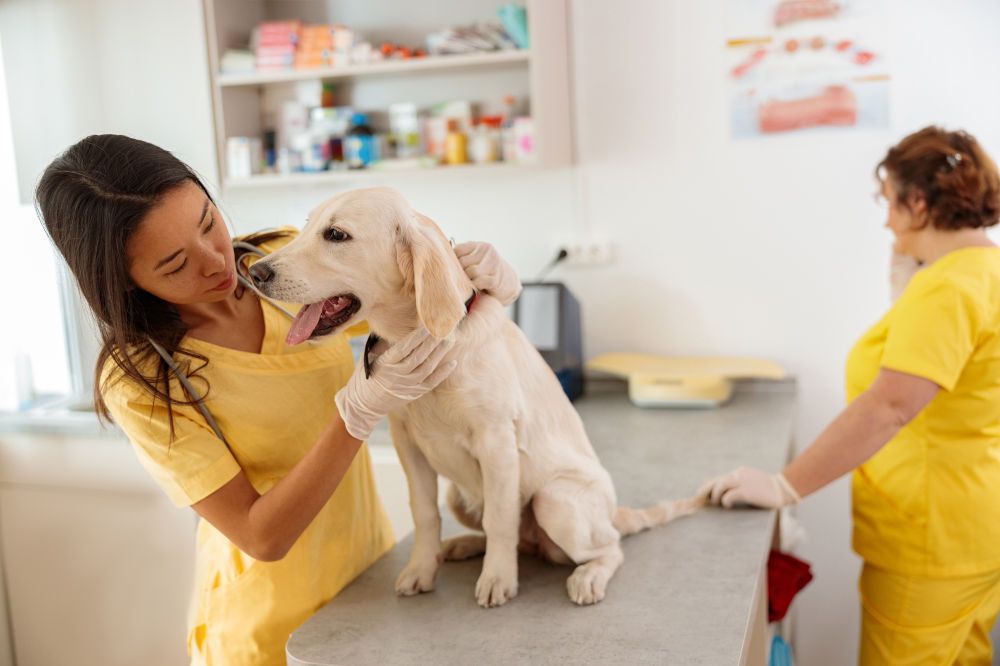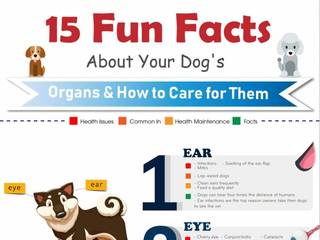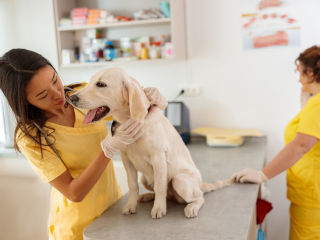Owners, of course, want to keep their pets as healthy as possible. No one wants to see these sweet dogs not feeling good! But unfortunately, everyone, humans and dogs alike, will face some health concerns at some point in their life, whether when they’re young, middle-aged, or old. Being aware of some of the most common illnesses, diseases, and conditions that our dogs may face will help us recognize the signs so we can seek veterinary treatment sooner rather than later.

Ear infections
Ear infections are, without a doubt, one of the most common ailments dogs tend to face. Some breeds, especially those with long drooping ears like Basset Hounds, Cocker Spaniels, and Bloodhounds, are more likely to experience an ear infection at some point in their life.
Ear infections are usually caused by a buildup of things like bacteria or yeast, which are more likely to develop in warm, moist areas like ears. Other factors that can contribute to ear infections are allergies, thyroid disease, autoimmune disease, a buildup of wax in the ear, or injury to the ear.
There are three types of common ear infections that dogs face. The first and most common type is called otitis externa. This type of ear infection refers to inflammation in the external ear canal. The other types are referred to as otitis media and interna. Otitis media refers to an infection of the middle ear, and interna refers to an infection of the internal ear. While not common, these two types of ear infections are especially dangerous and are usually the result of long-term untreated otitis externa. When an infection reaches the inner ear, dogs can experience things like facial paralysis, deafness, and vestibular signs like imbalance.
So what are some symptoms owners might notice if their dog might have an ear infection? Well, the first and probably most common sign is excessive head shaking. Ear infections are usually itchy, uncomfortable, and even painful. Dogs might shake their head a lot in an attempt to find relief or scratch their ears a lot. Some dogs may even rub their head and ears on the floor.
Other things you may notice would be crusting or scabbing inside the ears, redness, swelling, and irritation, as well as a possible dark discharge and bad odor coming from the ear. To treat ear infections, your vet will prescribe a medicated ear cleanser and possibly a topical medication, antibiotics, or anti-inflammatory medications. In order to reduce the risk of ear infections occurring, most people find it beneficial to check their dog’s ears frequently and to use an over-the-counter ear cleanser every two to three weeks.
Dental disease
Another common condition that dogs face is dental disease. In fact, it is said that over 80% of dogs who are ages three and older have some form of active dental disease. Diseases can include gingivitis, periodontitis, endodontic disease, an infection, or inflammation of the pulp of the tooth, all of which can eventually lead to tooth decay.
Dogs also are known to experience fractured teeth because of the things they chew on, so it is important to only give dogs chew toys, treats, and bones that offer some give and flexion so that dogs are less likely to break their teeth on hard surfaces. Gingivitis is often one of the first stages of dental disease that dogs will develop, and it is characterized by gums that have become irritated and inflamed. Many people don’t even know their dogs have this. However, it will eventually develop into periodontitis when plaque that has formed just below the already irritated and inflamed gum line starts to secrete toxic substances that damage the gum line and soft and bony tissue of the tooth. From there, the root of the tooth can go on to become affected.
During all of these stages, the immune system works overtime to try and fight off the bad bacteria. Unfortunately, once it has reached a certain stage, veterinarian intervention is usually needed, which can include surgical intervention resulting in the loss of many teeth. Many vets recommend regular teeth brushing at home as well as professional dental cleanings at the veterinarian’s office.
Some of the common signs of dental disease include bad breath, along with red, swollen, irritated, or bleeding gums. Other symptoms can include difficulty eating or chewing, weight loss or loss of appetite, visible tartar or plaque, drooling, discharge from the nose, swelling under the eyes, and the dog pawing at the teeth or mouth.
Arthritis
Arthritis is another condition that many dogs will experience in their life. In its most simplistic explanation, arthritis is an inflammation of the joints. The most common form of arthritis in dogs is osteoarthritis which is also sometimes known as degenerative joint disease.
It has been reported that it currently affects one out of every five dogs in the United States. In a dog without arthritis, joints have a type of cushion called cartilage that helps to protect the bones of joints from experiencing friction between bones. However, in a dog with arthritis, inflammation occurs, the cartilage can start to erode over time, and even bony growths or spurs can start to form around the joint. Most commonly affected in dogs are their hips, elbows, lower backs, knees, and wrists.
Symptoms of arthritis are often quite easy to recognize once you know what they are. Some of the main signs include stiffness, lameness, limping, reluctance to get up or walk, as well as changes in appetite like appetite loss or weight gain. Irritability and behavioral changes can also present as symptoms.
Arthritis is something that is commonly seen in old age, but some dogs may be more prone to developing it earlier on in life as well. A veterinarian can easily diagnose arthritis with a physical exam, and x-rays can help determine the severity. Once diagnosed, there are several options that you and your vet can discuss. If your dog is overweight, this will be one of the first things that will need to be addressed. Excess weight puts unnecessary stress on the joints, and dogs with arthritis who have lost weight have drastically improved.
Other things include focusing on diet and nutrition since adding certain fatty acids can be beneficial. Instead of one long walk every day, it may be best to switch to several short walks throughout the day. Physical rehabilitation, physical therapy, acupuncture, and massage have also all shown improvement for dogs with arthritis. Various anti-inflammatory drugs may be prescribed by your vet, as well as glucocorticoids like steroids or cortisone can also help. In extreme cases, surgery may be beneficial.
Parasites
We’ve likely all heard of the importance of flea and tick prevention. But there are also many other parasites out there that can affect our dogs as well. There are two different classifications for parasites in dogs which include internal parasites and external parasites. Fleas and ticks are primarily considered to be external parasites because they infest the outside of a dog’s body. Ticks are tiny little creatures that latch onto a dog’s or even a person’s skin to feed on their blood. Using tick preventative and keeping a close eye out for ticks, especially if your dog is in tick-infested areas, is incredibly important. When a tick latches on for a long time, there is an increased risk of diseases like Lyme disease or Rocky Mountain spotted fever being transmitted. Some types of ticks can even cause paralysis.
Similarly, fleas are also known to be blood-sucking pests. They often result in an infestation as they can go through their entire life cycle from egg to larvae, to pupae, and to adult, all while being on your dog. Moreover, they also can carry tapeworm eggs which can be transmitted to your dog as well.
Some examples of internal parasites include hookworms, roundworms, whipworms, and tapeworms. To test for these parasites, a veterinarian will often need a stool sample. One of the most serious types of parasite is the large roundworm parasite, commonly referred to as heartworm. Veterinarians recommend checking every year and having your dog take a preventative since these can be incredibly dangerous and take a long time to treat.
In order to prevent parasites, the best thing you can do is to take your dog in for regular veterinary check-ups and keep your dog on a flea and tick preventative as well as a heartworm preventative all year round.
UTI
Urinary Tract Infections, or UTIs, are quite a common occurrence, especially for female dogs. For both males and females, bacterial urinary tract infections affect about 14% of all dogs throughout their lifetime. UTIs usually occur because of different types of bacteria that make their way and colonize in the urinary tract. The most common bacteria to cause this is E. coli, but there are plenty of other bacteria and even fungi that can lead to infections.
One of the most common symptoms or indications of UTIs in dogs is the dog needing to be let outside more often, as well as having difficulty urinating. In some cases, the dog may whimper or cry out when trying to urinate. Some dogs may feel that they have to urinate so frequently that they end up having accidents in the house. You may also notice the licking and grooming around the urinary area. Additionally, other signs might be fever or cloudy or bloody urine.
Benign tumors
Another health concern that many dogs experience in their lives is tumors. In short, a tumor is caused by uncontrolled cell growth that serves no purpose. Now, there are two main types of tumors. The first is called a malignant tumor. This refers to cancerous tumors, which of course, will need veterinary diagnosis and treatment. The second is called a benign tumor, meaning that it is a harmless tumor.
Most dogs experience benign tumors at some point in their life, especially as they get into old age. They can come in a wide array of sizes. Some might look like a tick stuck to the skin, while others could be the size of a baseball.
There are a few different types of benign tumors dogs commonly get. The first are basal cell tumors, which are on the outermost layer of the skin. Lipomas are another common example and are often described as fatty tumors or growths. They occur in the subcutaneous tissue of the skin and are usually quite firm to the touch, and can be moved around without causing the dog any discomfort. Sweat gland tumors can also be found on the head and neck forming around hair follicles. Benign tumors are usually entirely harmless but could be problematic if they grow to a size where they start to affect bodily functions such as blood flow or the connection of nerves. As mentioned, though, not all tumors are harmless, so it will be important to have a veterinarian assess them.
Skin allergies
Other common health concerns for dogs are skin allergies of the skin. As far as allergies go, there are usually three main categories of allergies that can affect our dogs. Food allergies are one of them. Food allergies or sensitivities in dogs are often a reaction to products like milk, chicken, wheat, or sometimes beef.
Not all dogs will have or develop these allergies, but they do affect the skin and can cause other symptoms like vomiting and diarrhea, and other forms of stomach upset. Extreme cases of food allergies can result in hives and facial swelling. What people will often notice are infections in the paw pad or ears, red, irritated skin, itchiness, and excessive scratching behavior.
Secondly, there are various types of environmental allergens that can be problematic for some dogs. Things like dust and mold, as well as anything considered under the umbrella of seasonal allergies, can affect dogs. Some dogs are even allergic to various types of grass!
Like with food allergies, symptoms often present as infections or irritations in the paws or ears, but you may also notice redness and irritation around their eyes and muzzle, as well as on their bellies, underarms, and between their toes.
Finally, some dogs can be allergic to the saliva from fleas. Fleas already cause skin problems for dogs, but when the dog is allergic, they will suffer from especially itchy skin. A clue is to look at the base of their tail which is usually the first place to become red and inflamed.
Of all these skin allergies, dogs can present with a variety of symptoms. Some examples include excessive scratching, rubbing, licking, or chewing of the skin, hair loss, and red and flakey skin.
Obesity
One of the biggest threats facing our dogs today is obesity. It is a problem that affects humans and pets alike. In fact, over 56% of dogs in the U.S. are considered to be overweight or obese. While for pets, there is no exact definition between what is considered overweight and what is obese, there is a loose definition that an obese dog weighs more than 30% of its ideal body weight.
Overweight dogs have become quite normalized in today’s society as both people, and their pets become more sedentary. But where an extra five pounds is relatively harmless for people, for dogs, just those few extra pounds can do a lot of long-term damage. Obesity can lead to almost countless other serious health concerns, including diabetes, high blood pressure, kidney disease, arthritis, torn ligaments, bladder disease, liver disease, and more.
Dogs who are not overweight, on average, live 2.5 years longer than obese dogs. The best option is to help your dog get the right amount of exercise and to only offer an appropriate amount of high-quality foods.
Besides weighing in at the vet, the best way to tell if your dog is overweight is simply by looking. If, when you look down at your dog and notice that your pup is somewhat round or oval-shaped, chances are your dog is overweight. Dogs should have a defined waist, and while you shouldn’t be able to see their ribs, you should be able to easily feel them without anything more than a thin layer of fat in the way.
Parvovirus
Parvovirus is one of the most dangerous diseases that puppies and even adult dogs can face. It is an extremely contagious virus that most commonly affects unvaccinated dogs and puppies who are younger than four months old.
The virus primarily targets the dog’s gastrointestinal system and can be fatal even with the best care and treatment. Thankfully, when parvo is recognized early on and aggressive treatment begins immediately, dogs have a 90% survival rate.
Signs of parvovirus to look for are lethargy, loss of appetite, abdominal bloating or pain, fever or hypothermia, vomiting, and severe diarrhea. Following the onset of clinical signs, death can occur within only 48 to 72 hours. For unvaccinated dogs and puppies especially, it will be incredibly important to get to a vet right away if they show these symptoms.
To help prevent parvovirus, puppies should receive vaccinations as early as six weeks of age and with boosters to follow. Since their immunity is not yet built, it is important to use caution when taking a puppy out in public.
Places like pet stores, obedience classes, dog parks, grooming salons, or anywhere that dogs and puppies frequent can all harbor the virus, no matter how cleanly they are. Most importantly, never let your puppy or dog get near the fecal matter of other dogs. This is one of the easiest ways the virus can be spread.
Cancer
As sad as it is, dogs are just as likely to develop cancer as humans are. In fact, 1 in 4 dogs will develop cancer at some point in their life, and almost 50% of dogs ten and older will develop cancer. As mentioned earlier, some tumors can be malignant. Veterinarians will often need to take a tissue sample to confirm a diagnosis. But other forms of cancer may present differently.
Vets may require diagnostic studies like lab work, x-rays, or ultrasounds. For example, osteosarcoma, an aggressive cancer affecting the bones, can often be seen in x-rays. While there is no cure for every kind of cancer, thankfully, there are treatment options for dogs with cancer that can help the dogs be rid of the cancer or at least extend their lives or improve their quality of life. Some cancers require surgical intervention, like those involving tumors. Some, like osteosarcoma, might require an amputation of a leg to keep the cancer from spreading as quickly.
Depending on the type of cancer, some dogs also benefit from treatments like chemotherapy and radiation. While many associate such treatments with feeling miserable and sick during treatments, chemotherapy, and radiation don’t tend to have the same effect on dogs as it does on humans!
Early detection is still the best-case scenario for any type of cancer. It will be important to watch for signs and symptoms and visit the veterinarian regularly. Things to look for are, of course, new growths or lumps, limping, loss of appetite or weight loss, difficulty breathing, wounds or sores that won’t heal, increased thirst or urination, and lower energy levels. Owners know their dogs best so if you notice any changes or have any concerns, talk to your veterinarian. As mentioned, detecting cancer early on is the best way we can help our dogs.
Final Takeaways
Illness, disease and various conditions are, unfortunately, just a part of life. While we may be able to recognize that our dogs aren’t feeling good or that something is wrong, unfortunately, they can’t tell us exactly what they’re feeling.
Knowing what some of the common conditions they might face are, however, may help us identify problems sooner and therefore get our pups treatment sooner. Regular visits to your veterinarian for check-ups, vaccinations, and preventative care will also help ensure that we can keep our dogs as healthy as possible.
FAQ
Are dog illnesses contagious to humans?
Some dog illnesses can be contagious to humans, while others are not. Here are some examples: Rabies: This viral disease can be transmitted to humans through the bite of an infected animal, including dogs. It is a serious and potentially fatal disease that affects the nervous system. Salmonella: This bacterial infection can be transmitted to humans through contact with infected dog feces or through contaminated food or water. Symptoms include diarrhea, fever, and abdominal pain. Ringworm: This fungal infection can be transmitted to humans through contact with infected dogs or through contaminated objects, such as grooming tools or bedding. It causes circular patches of hair loss and can be itchy. Leptospirosis: This bacterial infection can be transmitted to humans through contact with infected dog urine or contaminated water. Symptoms include fever, muscle aches, and nausea.
What human diseases can dogs get?
Dogs can contract various diseases, some of which are similar to human diseases. Here are some examples of human diseases that dogs can get: Lyme disease: This bacterial infection is transmitted to dogs through the bite of infected ticks. It can cause symptoms such as fever, lethargy, and joint pain. Canine influenza: This respiratory disease is caused by influenza viruses and can cause symptoms such as coughing, fever, and nasal discharge. Parvovirus: This highly contagious viral disease can cause severe gastrointestinal symptoms in dogs, such as vomiting and diarrhea. Rabies: This viral disease can be transmitted to dogs through the bite of an infected animal, and it affects the nervous system. Salmonella: Dogs can contract salmonella from contaminated food or water, and it can cause symptoms such as vomiting and diarrhea. Heartworm disease: This disease is caused by a parasitic worm that is transmitted to dogs through mosquito bites. It can cause damage to the heart and lungs if left untreated.






